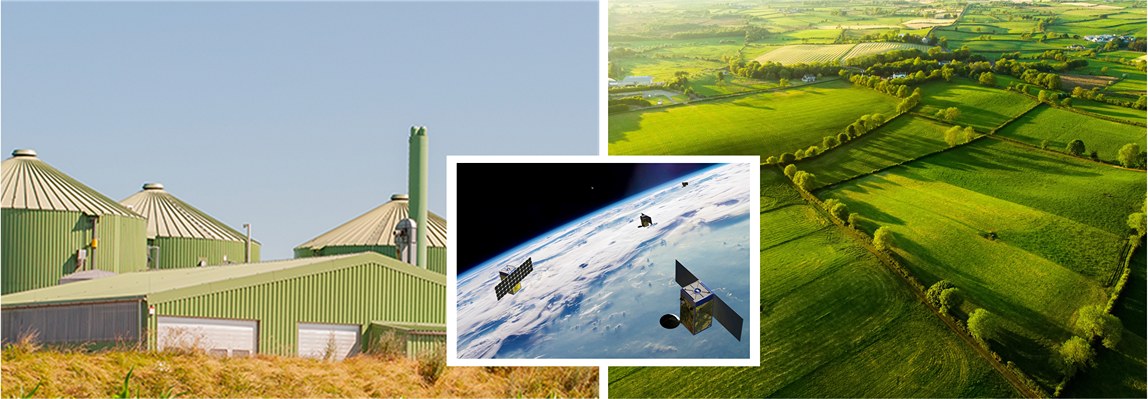
The Good, the Bad, and the Ugly of Satellite NTN connectivity use in Smart Agriculture
Introduction
Wireless connectivity is an integral part of making agricultural products “smart”. Many different technologies are commonly used for LAN (Wi-Fi, LoRa, ISM) within the farm and WAN (LTE-M1, NB-IOT, LoRa, and Sigfox) connectivity to get the data out. But how does one connect to the internet when WAN can’t reach? When the location of use is too far from existing tower infrastructure? Now designers have options for global WAN coverage using satellites and NTN technology.
Companies like SpaceX have significantly reduced the costs to deliver satellites into orbit, resulting in many new companies deploying Low Earth Orbit (LEO) satellite constellations. Allowing them to offer connectivity services similar to that of LPWAN, but with global coverage.
The global mobile broadband standards organization, 3GPP, laid the groundwork to support new technology by establishing standards for non-terrestrial networks (NTN) in 3GPP release 17 in 2022 (1). This paved the way for cellular chipset and infrastructure suppliers to create affordable connectivity solutions between devices and space. Companies building services on LEO satellites like Skylo have partnered with Mobile Network Operators (MNO) like Tmobile, Telefonica and Mobile Virtual Network Operators(MVNO) like EMnify, Soracom and Monogoto to create connectivity solutions that combine terrestrial and non-terrestrial systems. This allows designers to buy one SIM card that allows them to connect to cell towers when in range and switch over to satellite when out of cell tower range.
The Good
These new technological developments open up new capabilities in agricultural environments. For example, poultry barns are often on the outskirts of small communities, to minimize the cost for land and keep the smell away from the public. Traditional building monitoring solutions for power failure, fire alarms, and climate conditions aren’t always in the range of cellular networks. Hybrid cellular and Satellite NTN solutions are a perfect fit for this kind of application where the device check-ins are infrequent, and the data usage is typically event driven by alarm conditions. The SiloSpi’s NTN Satellite Connectivity transformation case study is a real-world example of this connectivity method, a real game changer for smart agriculture applications.
The Bad
In other cases, Satellite NTN may be able to extend range, but it’s not a good fit for high data use applications like precision farming. Tractor and implement monitoring solutions that enable precision farming generate gigabytes of data per day when plowing, planting, cultivating, fertilizing, and harvesting. Typically the data acquisition rates exceed the bandwidth of even cellular networks requiring a store and forward approach. In these applications, the device must have a large data storage capability on the device. During the farming activity the data is quickly stored into memory and can slowly be sync’d to a cloud resource as cellular or even Wi-Fi connectivity near the buildings allows for offloading the massive amounts of data.
The Ugly
Satellite NTN can only handle hundreds of bytes per minute, and at fairly high cost, making it not the right solution for any high data rate or high data volume application. With more and more competition and advances in technology in the satellite connectivity industry we can expect prices to go down and data rates to increase but we are a few years away from that reality.
Conclusion
Satellite NTN connectivity offers promising solutions for extending coverage in remote agricultural settings where traditional WAN networks fall short. While this technology excels in low-data applications, such as monitoring environmental conditions in poultry barns or managing other critical alerts, it falls short for high-bandwidth needs like precision farming due to current limitations in data rates and costs.
As the technology matures and evolves, with anticipated improvements in bandwidth and reductions in cost, satellite NTN connectivity could become an even more viable option for a broader range of agricultural applications. For now, careful consideration of your specific use case is essential to determine whether satellite connectivity is the right fit.
TxWireless has a wealth of experience implementing wireless agricultural solutions in and out of the farm environment. As you navigate device design decisions, we’re here to help you though the tough parts with product design and manufacturing capabilities.
Author:
Kurt Larson – VP North America
Footnotes
https://www.3gpp.org/specifications-technologies/releases/release-17




























